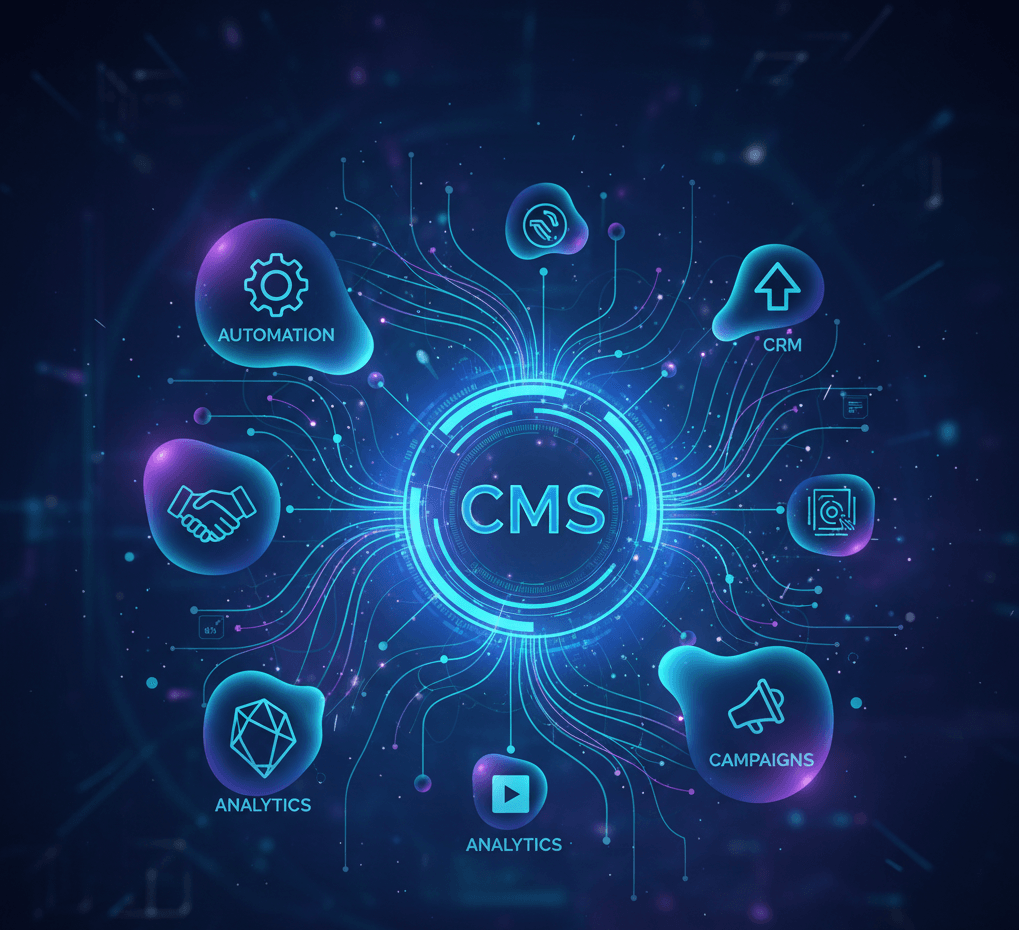Executive Summary
Integrating Sitefinity CMS with modern marketing automation platforms such as HubSpot, Marketo, Salesforce Marketing Cloud, or Adobe Campaign enables organizations to deliver personalized experiences, automate lead journeys, and unify cross-channel engagement.
But integration success isn’t just about technology it’s about architecture, measurement, and governance.
This paper outlines how to execute such an integration strategically and sustainably. It presents two viable architecture models, defines the metrics and dashboards to measure ROI, and proposes a governance structure that ensures collaboration between Marketing, Sales, and IT.
Together, these elements create a framework for scalable, intelligent, and measurable marketing transformation.
The Business Case for Integration
In today’s fragmented marketing landscape, every customer interaction generates valuable data but that data often lives in silos. Integrating Sitefinity CMS with your marketing automation tools breaks down those barriers, empowering teams to:
- Deliver personalized content at scale
- Automate lead nurturing and scoring
- Orchestrate cross-channel campaigns
- Measure end-to-end marketing ROI
- Accelerate time-to-market for new campaigns
The following sections move beyond “why” to focus on “how” giving your leadership team the clarity to plan and act.
Architecture Options for Integration
Your architecture choice will define scalability, maintainability, and cost over time. Below are two models to consider for integrating Sitefinity CMS with your marketing automation stack.
Option 1: Point-to-Point Integration Architecture
Overview
Each system (Sitefinity, CRM, Marketing Automation, Analytics) connects directly to one another via native connectors or APIs.
Illustration
Aspect | Advantages | Challenges |
| Speed to Deploy | Quick setup with native connectors (HubSpot, Salesforce, Marketo). | May become complex as systems multiply. |
| Cost | Lower upfront cost; often uses out-of-the-box connectors. | Maintenance costs increase with each added system. |
| Control | Direct data flow; simple to manage initially. | Harder to enforce data consistency and governance across many links. |
| Scalability | Suitable for 2–4 connected systems. | Does not scale well beyond 4–5 integrations; high risk of “integration sprawl.” |
| Use Case Fit | Ideal for organizations starting integration efforts or with simple data flows. | Unsuitable for enterprises aiming for unified, omnichannel orchestration. |
Summary
A point-to-point model offers speed and simplicity for smaller ecosystems but can quickly become fragile as new tools and data requirements emerge.
Option 2: CDP-Orchestrated Architecture
Overview
A Customer Data Platform (CDP) such as Sitefinity Insight, Segment, or Tealium serves as a central orchestration layer, managing data exchange between all systems.
Illustration:
Aspect | Advantages | Challenges |
| Data Consistency | CDP maintains a unified customer profile and single source of truth. | Requires upfront investment and data strategy design. |
| Scalability | Easily scales across dozens of systems and channels. | Higher initial setup and integration effort. |
| Governance | Centralized control over data access, compliance, and enrichment. | Needs strong data stewardship processes. |
| Intelligence | Enables predictive analytics, personalization, and real-time triggers. | May require CDP expertise or managed services. |
| Use Case Fit | Ideal for enterprises focused on long-term scalability and real-time personalization. | Less suitable for small teams or short-term pilots. |
Summary
The CDP model is the future-proof approach. It allows Sitefinity CMS to both consume and contribute rich behavioral data within a unified orchestration layer enabling enterprise-wide personalization, analytics, and automation.
Metrics & Executive Dashboard Design
To justify and guide your investment, define metrics that connect marketing actions to business outcomes from day one.
Core KPIs
| KPI Category | Metric | Definition | Strategic Insight |
| Engagement | Average Session Duration | Time spent per visit on Sitefinity pages. | Indicates relevance of personalized content. |
| Conversion | Lead-to-MQL Rate | % of leads that qualify for nurturing. | Measures nurturing effectiveness. |
| Pipeline | MQL-to-SQL Conversion | % of marketing-qualified leads that convert to sales opportunities. | Aligns marketing quality with sales outcomes. |
| Revenue Impact | Pipeline Contribution | % of closed-won revenue influenced by marketing automation. | Proves business impact of integration. |
| Efficiency | Campaign Launch Time | Average time from concept to live campaign. | Measures operational agility. |
| Data Health | Sync Accuracy Rate | % of successfully synchronized contacts and events. | Monitors integration reliability. |
Executive Dashboard Blueprint
Dashboard Sections:
At a Glance:
- Total site visitors (by segment)
- Conversion funnel (visitor → lead → MQL → SQL → opportunity)
Engagement Performance:
- Content heatmap from Sitefinity
- Engagement rate by personalization segment
Campaign Effectiveness:
- Email + web cross-channel performance
- Attribution model showing campaign-to-revenue linkage
Operational Health:
- Data sync accuracy
- Average campaign creation time
- Integration uptime
Executive Summary View (Monthly):
- Marketing ROI %
- Pipeline contribution trend
- Customer retention impact
This dashboard can be built using Power BI, Tableau, or Sitefinity Insight, combining marketing automation data (HubSpot, Marketo) and CMS engagement metrics.
Governance Model for a Unified Martech Ecosystem
To sustain the integration and ensure accountability, your organization needs a governance framework that aligns Marketing, Sales, and IT around shared data and performance objectives.
Governance Principles
- Single Source of Truth: Marketing data must flow through one validated integration path.
- Shared Ownership: Marketing owns campaign logic; IT owns infrastructure; Sales owns CRM data quality.
- Continuous Optimization: Governance must evolve with business goals and system updates.
Roles and Responsibilities
| Function | Primary Responsibilities |
| Marketing | Defines audience segments, campaign workflows, personalization rules, and KPIs. Owns lead generation and nurture processes. |
| Sales | Ensures CRM data accuracy, provides feedback on lead quality, and uses integrated data for follow-up prioritization. |
| IT / Digital Ops | Maintains the integration architecture (APIs, connectors, CDP), monitors data flow, ensures compliance and uptime. |
| Data Governance Committee | Cross-functional team (Marketing Ops, Sales Ops, IT Security) that meets monthly to review integration performance, KPIs, and upcoming enhancements. |
Governance Processes
- Integration Change Requests: All new connectors or workflows must be reviewed by IT and Marketing Ops for compliance.
- Data Hygiene Reviews: Monthly validation of data accuracy, duplicates, and sync failures.
- Quarterly Optimization Cycles: Marketing and Sales evaluate campaign results and adjust rules, scoring, and personalization strategies.
- Executive Oversight: Quarterly dashboards are presented to leadership to track ROI and business impact.
Roadmap for Execution
| Phase | Milestone | Key Deliverables |
| Phase 1: Discovery | Define goals, audiences, and system inventory. | Integration scope document, KPI definitions. |
| Phase 2: Architecture Selection | Choose between Point-to-Point or CDP model. | Architecture blueprint and cost analysis. |
| Phase 3: Implementation | Build and test integrations, dashboards, and workflows. | Working integrations, initial executive dashboard. |
| Phase 4: Launch & Governance | Go live and initiate governance cycles. | Live dashboards, first quarterly governance review. |
| Phase 5: Optimization | Use insights to refine content, scoring, and automation. | Updated rules, improved KPIs, and executive ROI report. |
Conclusion
Integrating Sitefinity CMS with your marketing automation platform is not just a technical project it’s a strategic transformation of how your organization connects with customers, measures success, and scales operations.
By adopting a CDP-driven architecture, defining clear KPIs and dashboards, and establishing cross-functional governance, you can ensure this initiative delivers measurable business impact from day one.
This framework gives your leadership team the clarity and confidence to invest, execute, and continuously prove the ROI of a modern, connected marketing ecosystem.




